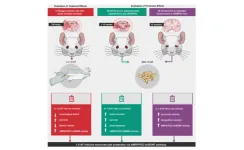(Press-News.org) Researchers have identified a new way to screen genes that cause several different types of cancers to grow, identifying particularly promising targets for precision oncology in oral and esophageal squamous cancers.
The study, published in this month’s issue of Cell Reports, used 3-dimensional models of organ tissues called organoids to identify and test potential gene targets from The Cancer Genome Atlas.
“There’s a tremendous amount of data in The Cancer Genome Atlas, and the field has developed life-prolonging and lifesaving precision medicines. But only a minority of these data tell us how cancers grow and whether it’s a drug target,” explained lead author Dr. Ameen Salahudeen, an assistant professor of medicine and biochemistry at the University of Illinois Chicago, and formerly a postdoctoral fellow in the laboratory of Calvin Kuo at Stanford University when the research was initiated. “We needed a scalable, functional method to make heads or tails of the data in terms of what’s driving cancer growth and whether it can be targeted.”
In order to pinpoint the genes that cause tumors to grow, the researchers decided to focus on areas of the genome that displayed two things: regions possessing abnormally high copies of the same gene, something common to many types of cancer, and regions with high levels of RNA expression, which would indicate that those genes are involved in tumor growth. To do this, they used a novel algorithm developed at Stanford by Dr. Jose Seoane, who was at the time in the laboratory of Christina Curtis.
The team identified promising regions within the genome for six different cancers: esophageal, oral cavity, colon, stomach, pancreatic and lung. Next, they built tumor organoids — small tumor tissues in a dish — for each of the six organs and tested their candidate genes on the organoids to see which were associated with growing tumors.
Using organoids for this step is an improvement over previous standard methods, Salahudeen explained. The immortalized cell lines typically used in cellular cancer research often have many additional mutations occurring after years of being grown in the laboratory “that really confound things,” he said. And testing this many potential genes in mice would be unscalable and take years.
In collaboration with Dr. David Root at the Broad Institute and Dr. Bill Hahn at the Dana Farber Cancer Institute, the team then screened the organoids using lentivirus libraries of these genes. The organoids revealed particularly interesting results for squamous cancers of the oral cavity and esophagus, both of which have very few known driver genes that could be targeted with drugs. Furthermore, the researchers tested a clinically available small molecule — a type of drug known as an FGFR inhibitor — on the esophageal organoids and were able to shrink the tumor.
“That gene, FGF3, is amplified in nearly half of esophageal squamous cancers and is known to interact with FGFR,” Salahudeen said. “So this could potentially benefit nearly half of esophageal cancer patients.”
Salahudeen, who is a member of the University of Illinois Cancer Center, said the next step is to investigate existing clinical FGFR inhibitors in this new indication within esophageal squamous cancer patients and to continue investigating other potentially promising genes that the study identified.
Other authors on the paper include co-lead author Kanako Yuki in the Calvin Kuo lab at Stanford. Funding for the study came from the NCI Cancer Target Discovery and Development Network to Kuo and William Hahn; the National Institute for Dental and Craniofacial Research; “LaCaixa” Foundation; Emerson Collective; Ludwig Cancer Research and Stand Up To Cancer to Kuo.
Written by Emily Stone
END
Growing microtumors in a dish helps rapidly identify genes that drive tumor growth
2023-11-28
ELSE PRESS RELEASES FROM THIS DATE:
New research compares five retinoids for anti-photoaging therapy
2023-11-28
Over the past decades, increasing evidences have demonstrated that five retinoids, including retinol (ROL), retinol acetate (RAc), retinol propionate (RP), retinol palmitate (RPalm), and hydroxypinacolone retinoate (HPR), can be potential therapeutic agents for skin photoaging. However, therapeutic efficacies and biosafety have never been compared to these compounds. This study aimed to determine the optimal retinoid type(s) for anti-photoaging therapy both in vitro and in vivo.
The data demonstrated that four retinoids (RPalm, RP, HPR and ROL) but not RAc were effective for anti-photoaging treatment at 5 μg/mL in vitro, with action mechanisms associated with antioxidative, ...
Can health, lifestyle changes protect elders from Alzheimer's?
2023-11-28
As more medications move toward federal approval for Alzheimer’s disease, a new study led by researchers at UC San Francisco and Kaiser Permanente Washington has found that personalized health and lifestyle changes can delay or even prevent memory loss for higher-risk older adults.
The two-year study compared cognitive scores, risk factors and quality of life among 172 participants, of whom half had received personalized coaching to improve their health and lifestyle in areas believed to raise the risk of Alzheimer’s, such as uncontrolled diabetes and physical inactivity. These participants were ...
Millions of kids in U.S. have inadequate health care coverage
2023-11-28
November 28, 2023-- Inadequate health coverage is a particular problem for commercially insured children, according to a new study released by Columbia University Mailman School of Public Health. The research shows that coverage gaps are affecting publicly insured children as well. Until now, prior research had focused on documenting rates and trends in insurance consistency for children covered by all insurance types. The findings are published in JAMA Health Forum.
“While uninsurance among children has generally been declining in the U.S., our results highlight the need for a renewed focus on making sure that children’s ...
NIH awards $2.6 million to Wayne State to develop new filtration platform for insulin administration
2023-11-28
DETROIT – A Wayne State University College of Engineering professor has received a $2.65 million award from the National Institute of Diabetes and Digestive and Kidney Diseases of the National Institutes of Health to develop a novel filtration platform to improve an advanced drug delivery device to optimize diabetes insulin treatments.
Subcutaneous insulin administration (SIA) technology has improved significantly over the past two decades, but SIA technology failure and underlying tissue damage caused by insulin phenolic preservatives ...
Mayo Clinic Board of Trustees approves plans to transform healthcare, improve experience for staff and patients, redesign Rochester campus
2023-11-28
ROCHESTER, Minn. — Mayo Clinic’s Board of Trustees has approved Bold. Forward. Unbound. in Rochester, a multiyear strategic initiative that advances Mayo Clinic’s Bold. Forward. strategy to Cure, Connect and Transform healthcare for the benefit of patients everywhere. It reimagines Mayo Clinic’s downtown Rochester campus and introduces new facilities with a combination of innovative care concepts and digital technologies that will give Mayo Clinic the ability to scale transformation ...
Threats against public health workers doubled during the COVID-19 pandemic
2023-11-28
While doctors and nurses were hailed as the frontline heroes of the COVID-19 pandemic, their counterparts in public health were experiencing threats. During the pandemic, threats against public health workers reached an all-time high. After the vaccine was released, those threats increased and changed in nature, according to a longitudinal study conducted during the first year of the pandemic by Jennifer Horney, founder of the University of Delaware Epidemiology Program in the College of Health Sciences.
The results, recently published in an open-access commentary in Public Health in Practice, show a strong need for expanded legal protections ...
Reducing inequitable health outcomes requires reducing residential segregation
2023-11-28
The U.S. must reduce racial residential segregation if it is to reduce racial disparities in health outcomes, according to a recently published study by researchers at Tufts University School of Medicine. The research on 220 metropolitan areas nationwide between 1980 and 2020 found strong links between trends in racial residential segregation and racial disparities in early death rates from a variety of causes.
The study is the first known to examine the association between changes in racial segregation over time ...
Manard named recipient of 2023 JAAS Emerging Investigator Lectureship
2023-11-28
Manard named recipient of 2023 JAAS Emerging Investigator Lectureship
Benjamin Manard, an analytical chemist in the Chemical Sciences Division of the Department of Energy’s Oak Ridge National Laboratory, has been selected for the 2023 Emerging Investigator Lectureship from the Journal of Analytical Atomic Spectrometry. JAAS is a publication of the Royal Society of Chemistry that shares innovative research on the fundamental theory and application of spectrometric techniques. Manard is the first winner of this award from a Department of Energy ...
Alcohol consumption may have positive and negative effects on cardiovascular disease risk
2023-11-28
FOR IMMEDIATE RELEASE
November 28, 2023
Contact:
Jillian McKoy, jpmckoy@bu.edu
Michael Saunders, msaunder@bu.edu
Lisa LaPoint, lisa.lapoint@tufts.edu
##
While past research has indicated that moderate alcohol consumption can lower one’s risk of cardiovascular disease (CVD), more recent studies suggest that moderate levels of drinking may be hazardous to heart health. ...
Anti-aging effects of 1,5-anhydro-D-fructose on brain diseases via AMPK activation
2023-11-28
A new research paper was published in Aging (listed by MEDLINE/PubMed as "Aging (Albany NY)" and "Aging-US" by Web of Science) Volume 15, Issue 21, entitled, “1,5-anhydro-D-fructose induces anti-aging effects on aging-associated brain diseases by increasing 5’-adenosine monophosphate-activated protein kinase activity via the peroxisome proliferator-activated receptor-γ co-activator-1α/brain-derived neurotrophic factor pathway.”
5’-Adenosine monophosphate-activated protein kinase (AMPK) is a metabolic sensor that serves as a cellular housekeeper; it also controls energy homeostasis and stress resistance. Thus, correct regulation ...


